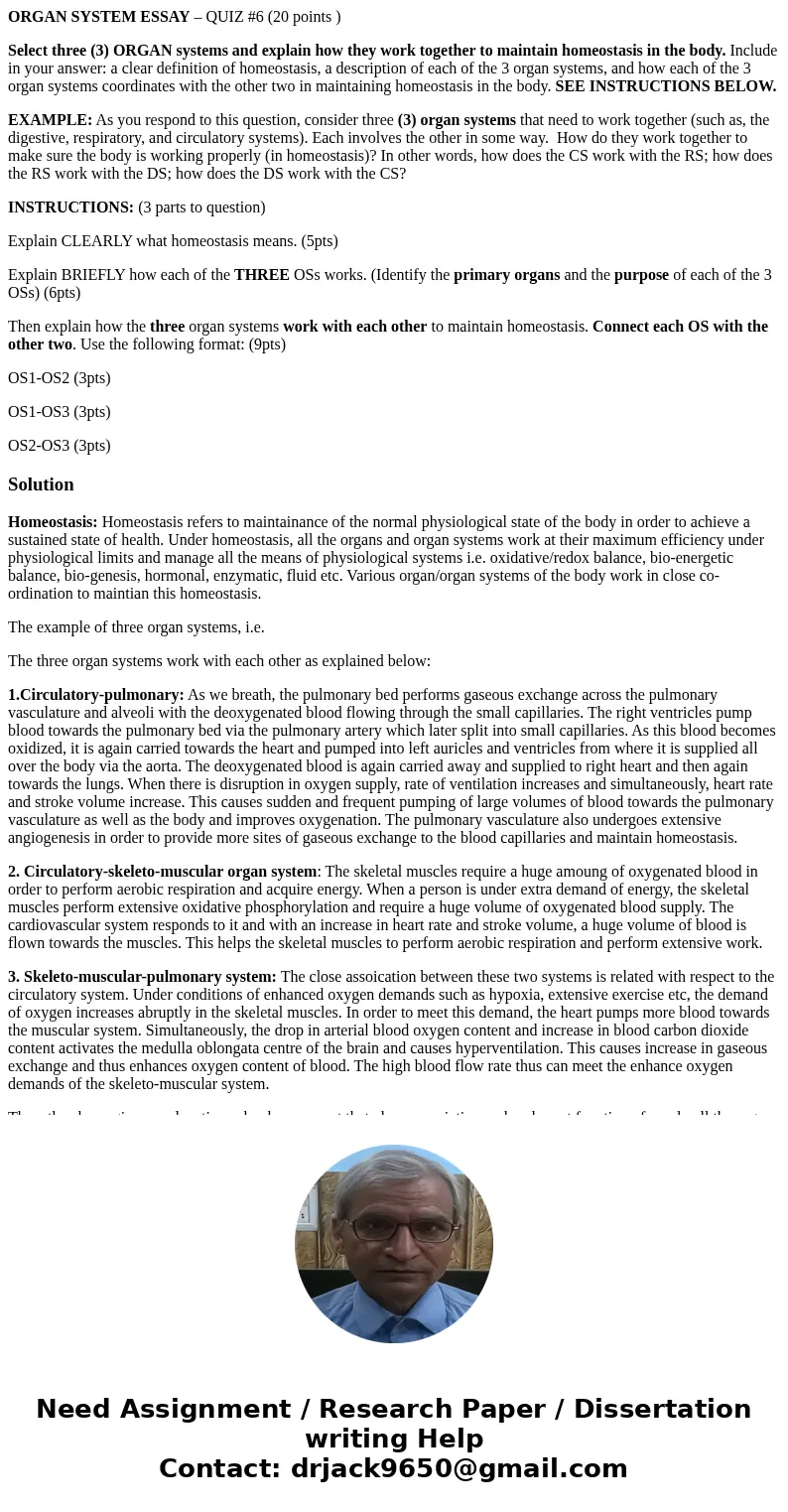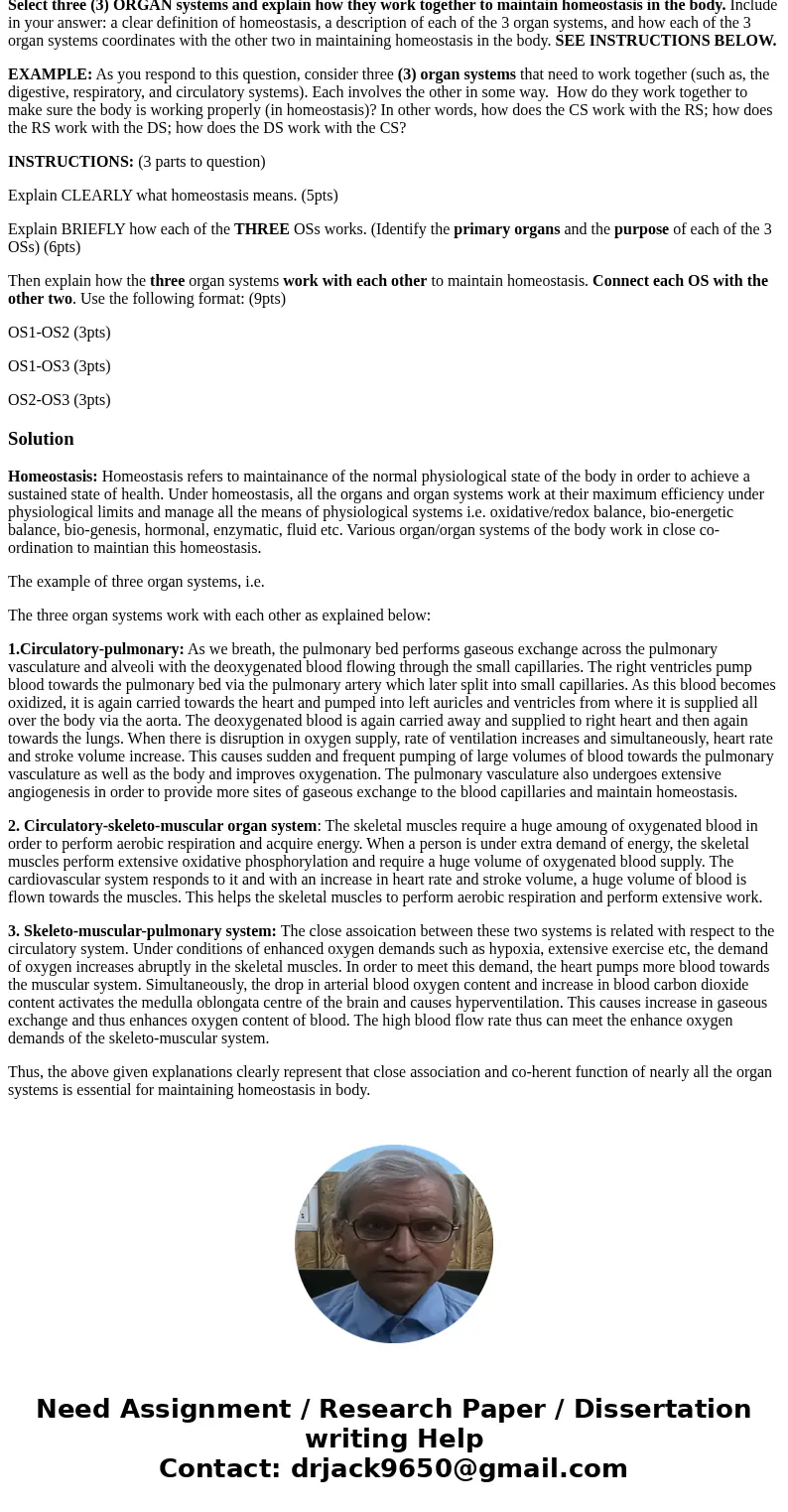ORGAN SYSTEM ESSAY QUIZ 6 20 points Select three 3 ORGAN s
ORGAN SYSTEM ESSAY – QUIZ #6 (20 points )
Select three (3) ORGAN systems and explain how they work together to maintain homeostasis in the body. Include in your answer: a clear definition of homeostasis, a description of each of the 3 organ systems, and how each of the 3 organ systems coordinates with the other two in maintaining homeostasis in the body. SEE INSTRUCTIONS BELOW.
EXAMPLE: As you respond to this question, consider three (3) organ systems that need to work together (such as, the digestive, respiratory, and circulatory systems). Each involves the other in some way. How do they work together to make sure the body is working properly (in homeostasis)? In other words, how does the CS work with the RS; how does the RS work with the DS; how does the DS work with the CS?
INSTRUCTIONS: (3 parts to question)
Explain CLEARLY what homeostasis means. (5pts)
Explain BRIEFLY how each of the THREE OSs works. (Identify the primary organs and the purpose of each of the 3 OSs) (6pts)
Then explain how the three organ systems work with each other to maintain homeostasis. Connect each OS with the other two. Use the following format: (9pts)
OS1-OS2 (3pts)
OS1-OS3 (3pts)
OS2-OS3 (3pts)
Solution
Homeostasis: Homeostasis refers to maintainance of the normal physiological state of the body in order to achieve a sustained state of health. Under homeostasis, all the organs and organ systems work at their maximum efficiency under physiological limits and manage all the means of physiological systems i.e. oxidative/redox balance, bio-energetic balance, bio-genesis, hormonal, enzymatic, fluid etc. Various organ/organ systems of the body work in close co-ordination to maintian this homeostasis.
The example of three organ systems, i.e.
The three organ systems work with each other as explained below:
1.Circulatory-pulmonary: As we breath, the pulmonary bed performs gaseous exchange across the pulmonary vasculature and alveoli with the deoxygenated blood flowing through the small capillaries. The right ventricles pump blood towards the pulmonary bed via the pulmonary artery which later split into small capillaries. As this blood becomes oxidized, it is again carried towards the heart and pumped into left auricles and ventricles from where it is supplied all over the body via the aorta. The deoxygenated blood is again carried away and supplied to right heart and then again towards the lungs. When there is disruption in oxygen supply, rate of ventilation increases and simultaneously, heart rate and stroke volume increase. This causes sudden and frequent pumping of large volumes of blood towards the pulmonary vasculature as well as the body and improves oxygenation. The pulmonary vasculature also undergoes extensive angiogenesis in order to provide more sites of gaseous exchange to the blood capillaries and maintain homeostasis.
2. Circulatory-skeleto-muscular organ system: The skeletal muscles require a huge amoung of oxygenated blood in order to perform aerobic respiration and acquire energy. When a person is under extra demand of energy, the skeletal muscles perform extensive oxidative phosphorylation and require a huge volume of oxygenated blood supply. The cardiovascular system responds to it and with an increase in heart rate and stroke volume, a huge volume of blood is flown towards the muscles. This helps the skeletal muscles to perform aerobic respiration and perform extensive work.
3. Skeleto-muscular-pulmonary system: The close assoication between these two systems is related with respect to the circulatory system. Under conditions of enhanced oxygen demands such as hypoxia, extensive exercise etc, the demand of oxygen increases abruptly in the skeletal muscles. In order to meet this demand, the heart pumps more blood towards the muscular system. Simultaneously, the drop in arterial blood oxygen content and increase in blood carbon dioxide content activates the medulla oblongata centre of the brain and causes hyperventilation. This causes increase in gaseous exchange and thus enhances oxygen content of blood. The high blood flow rate thus can meet the enhance oxygen demands of the skeleto-muscular system.
Thus, the above given explanations clearly represent that close association and co-herent function of nearly all the organ systems is essential for maintaining homeostasis in body.


 Homework Sourse
Homework Sourse